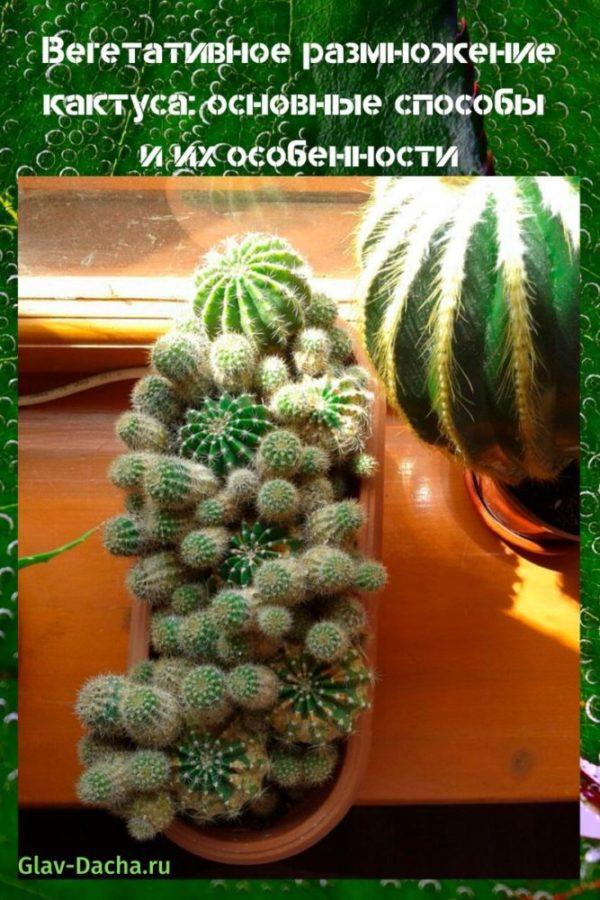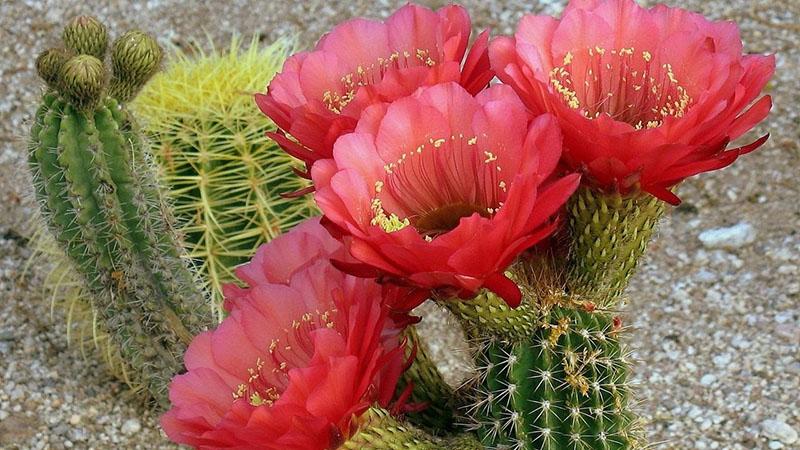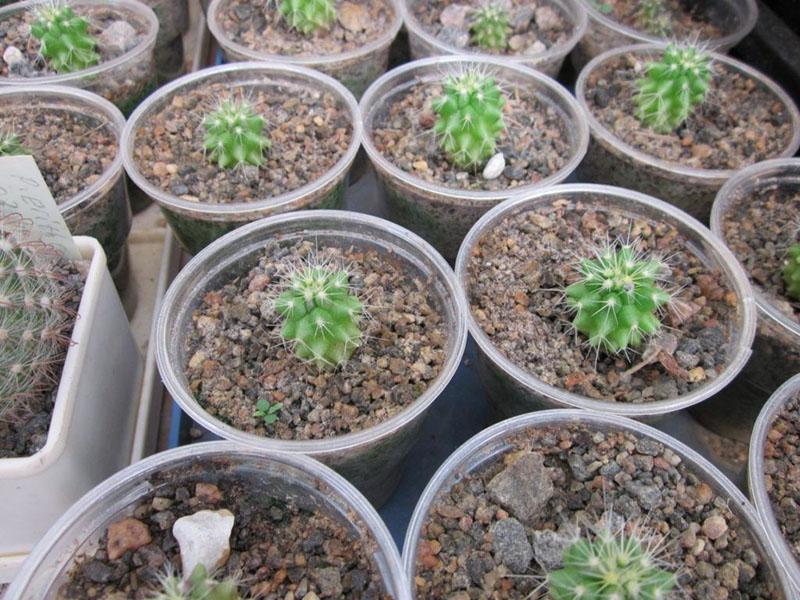Vegetative propagation of a cactus: the main methods and their features
 Vegetative propagation of a cactus is an easy way to grow a young plant with a beautiful, lush flowering, which does not cause any particular difficulties for flower growers. Plants root well and give a minimum percentage of rejects when planting new roots. But for this you need to take into account the basic nuances and specifics of the process, as well as choose the most suitable breeding method.
Vegetative propagation of a cactus is an easy way to grow a young plant with a beautiful, lush flowering, which does not cause any particular difficulties for flower growers. Plants root well and give a minimum percentage of rejects when planting new roots. But for this you need to take into account the basic nuances and specifics of the process, as well as choose the most suitable breeding method.
Vegetative propagation of a cactus: the main species

There are several ways to reproduce cacti at home, which are no different from the ways plants appear in the wild:
- Seed propagation is considered one of the most troublesome and laborious, but it allows you to get several strong seedlings at the same time.
- Reproduction by shoots (cuttings) is one of the simplest and most effective ways. It allows you to quickly get a strong new plant, but adds additional stress to the mother cactus.
- Breeding by babies is an effective but very slow method. For such reproduction, children are taken from old plants, and the entire reproduction process can take up to 2-3 months.
- Grafting - the essence of the methods is to transplant the cuttings of the mother to another plant.
When choosing the best method, you need to take into account the plant variety, because some varieties of cacti do not bloom - and, accordingly, do not form seeds. In such cases, propagation by shoots or cuttings is used.
Seed propagation of cacti
 Seed propagation is considered to be one of the most labor-intensive methods of growing cacti. The disadvantage of this method is the long germination of seedlings from seeds. Some types of cacti require at least 2-3 months for this.
Seed propagation is considered to be one of the most labor-intensive methods of growing cacti. The disadvantage of this method is the long germination of seedlings from seeds. Some types of cacti require at least 2-3 months for this.
Among the advantages of seed propagation of cacti is the ability to simultaneously grow a large number of young plants.
Step-by-step propagation of cactus by seeds:
- first of all, you need to collect seeds from a flower - it is advisable to do this 1-2 days before its complete wilting;

- pour the collected seeds onto a sheet of paper and leave them to dry for 48 hours;
- for growing seeds, it is best to use a special mini-greenhouse, which can be bought at any flower shop, or a small plastic container with small holes in the bottom;
- use a regular cactus substrate for planting seeds;
- as drainage - fine expanded clay or perlite;
- rinse the container with warm water and baking soda;
- pour soil into a container and water abundantly;
- place the seeds on the soil at a distance of about 1 cm, lightly pressing down with your fingers, but not digging in;
- you need to ensure that the seeds are sheltered from cold and drafts.
 Cover the plastic container with the seeds with plastic wrap and leave until the first shoots appear. The first pick is carried out after 10-30 days, depending on the rate of appearance of green shoots.
Cover the plastic container with the seeds with plastic wrap and leave until the first shoots appear. The first pick is carried out after 10-30 days, depending on the rate of appearance of green shoots.
How to root a cactus after germination - for this, the seedlings need to be watered abundantly, at least 1 watering every 2-3 days.
 Subsequent picks of young plants are carried out every 8 weeks.
Subsequent picks of young plants are carried out every 8 weeks.
Vegetative propagation of a cactus by children
 Reproduction of cacti by children is considered the safest, most effective, but rather slow way of growing a cactus.The plant itself forms future seedlings and separates it from the mother.
Reproduction of cacti by children is considered the safest, most effective, but rather slow way of growing a cactus.The plant itself forms future seedlings and separates it from the mother.
 Therefore, flower growers do not have a problem of how to separate the children from the cactus - it is enough to simply pinch it off slightly as soon as they reach 1.5-2 cm.After that, they easily take root, turning into independent plants with rapid growth and lush, abundant flowering.
Therefore, flower growers do not have a problem of how to separate the children from the cactus - it is enough to simply pinch it off slightly as soon as they reach 1.5-2 cm.After that, they easily take root, turning into independent plants with rapid growth and lush, abundant flowering.
How to graft a cactus at home with the help of children:
- Pinch off the baby from the plant, remove all maternal residues, pour on a sheet of paper and leave to dry for 3 days.
- If the baby does not separate from the mother plant on its own, cut it off at the very base with a sharp knife, rubbed with alcohol or calcined in a fire.

- Place the drainage in a small flower pot - it should take up about ¼ of the capacity.
- Pour soil on top of the drain and water abundantly, tamp a little.
- Plant the baby and add soil to the level of the root collar, but do not cover it.

- Place the pot with the planted baby for 3 days in the dark, then rearrange it for another 3 days in a brighter place, but without the penetration of direct sunlight.

7 days after planting, the baby can be watered.
As soon as the first green needles appear on the plant, it can be rearranged on a windowsill or in another sunny place.
Propagation by cuttings
 Dividing a cactus with cuttings is the easiest and fastest way to grow new plants. This method is similar to reproduction by children, with the difference that the grower does not need to wait for their appearance, he separates the necessary escape on his own.
Dividing a cactus with cuttings is the easiest and fastest way to grow new plants. This method is similar to reproduction by children, with the difference that the grower does not need to wait for their appearance, he separates the necessary escape on his own.
 Cutting significantly speeds up the growing time of new plants. Before cutting and rooting a cactus shoot, you need to choose the most healthy, viable and well-established plants without dry and sluggish parts. Cutting is best done in spring or early summer - this is a period of active growth of cacti.
Cutting significantly speeds up the growing time of new plants. Before cutting and rooting a cactus shoot, you need to choose the most healthy, viable and well-established plants without dry and sluggish parts. Cutting is best done in spring or early summer - this is a period of active growth of cacti.
How to propagate a cactus by cuttings:
- Cut off the top of the mother plant with a sterile, sharp knife disinfected in rubbing alcohol or vodka.

- In order to root the cutting, sharpen the cut surface a little, giving the cutting a conical shape.
- Cuttings should not be sharpened too sharply, as this can damage the delicate core of the plant.
- Prepared cuttings must be well rooted and protected from pathogens of fungal diseases. To do this, dry them for a week.
- While drying, keep the daughter shoot of the cactus in an upright position - this will significantly speed up the formation of the root system.
After the tops of new roots appear, the cuttings can be transplanted into flower pots with a loose cactus substrate.
 At first, the daughter shoots are easy enough to spray. Watering is carried out only after the formation of a sufficient number of strong, well-absorbing roots.
At first, the daughter shoots are easy enough to spray. Watering is carried out only after the formation of a sufficient number of strong, well-absorbing roots.
The mother plant, after cutting and rooting the upper part, can be well fed with fertilizers and grown further. After 2-3 weeks, new, young shoots appear from the lateral areoles of the trimmed hemp. They can also be cut and rooted after reaching the desired size.
 Thus, growers can constantly replenish their "green collection" with new and interesting specimens.
Thus, growers can constantly replenish their "green collection" with new and interesting specimens.
Reproduction of leaf cacti can be carried out using leaf plates. In this case, place the freshly plucked leaf cutting on top of well-moistened soil. Can be deepened a little by pressing lightly with your fingers. This is a simple and effective way to grow leafy cactus varieties.
Vegetative propagation of a cactus by grafting
 For vegetative propagation of a cactus by grafting, the so-called scion and rootstock are used - this is the upper part of the plant and the lower cut, on which the scion is placed.
For vegetative propagation of a cactus by grafting, the so-called scion and rootstock are used - this is the upper part of the plant and the lower cut, on which the scion is placed.
The vaccination method has several advantages over other breeding methods:
- stimulates growth and ensures lush flowering of plants;
- makes it possible to restore a damaged, sluggish or aesthetically unattractive plant;
- ideal for breeding hybrid, rare varieties of cacti.
 The plant can be grafted in various ways - by making a horizontal, vertical or V-shaped cut on a cactus. Care must be taken to ensure that the scion and stock are exactly the same shape.
The plant can be grafted in various ways - by making a horizontal, vertical or V-shaped cut on a cactus. Care must be taken to ensure that the scion and stock are exactly the same shape.
You need to fix the cut part of the plant very quickly. It should not dry out, otherwise reproduction will fail. For strength, you can additionally use elastic bands or strong ribbons, threads.
In some cases, the scion and rootstock may not take root. In this case, you must use a different graft. You can make several new cuts by trying to reattach the plant parts. Most often this gives a good result.
There are several methods of vegetative propagation of cacti, which are selected taking into account the characteristics and variety of the plant. Using these simple and effective techniques, you can significantly expand your home garden and decorate your home with attractive, original plants.